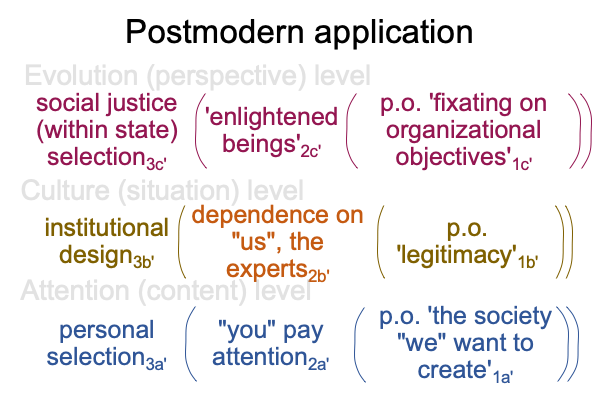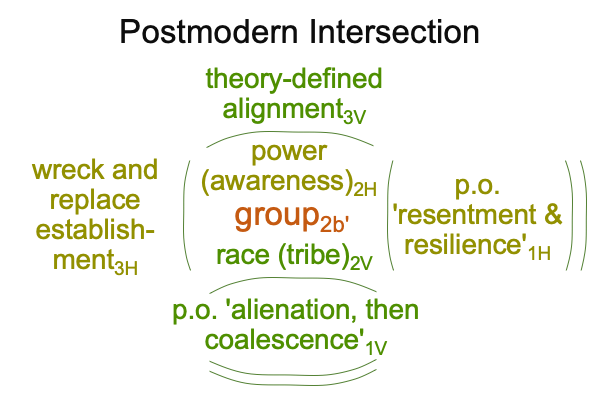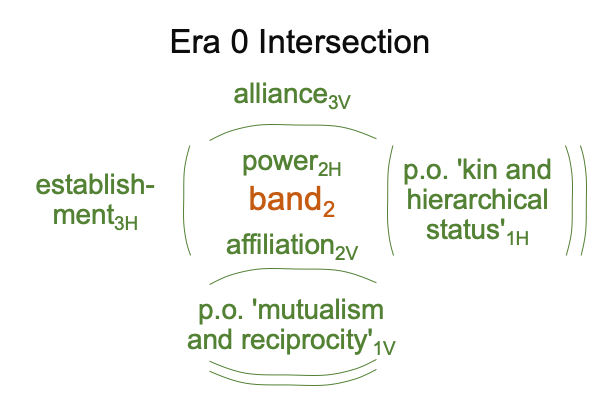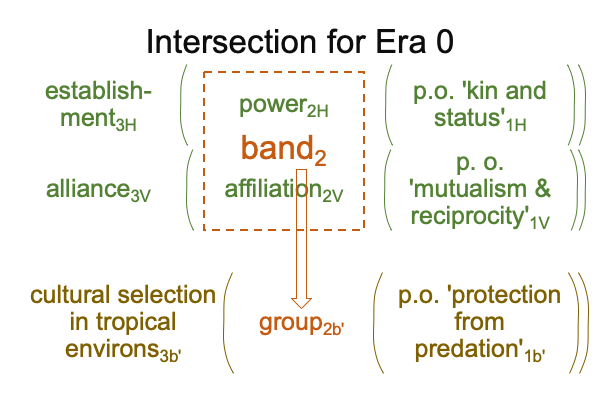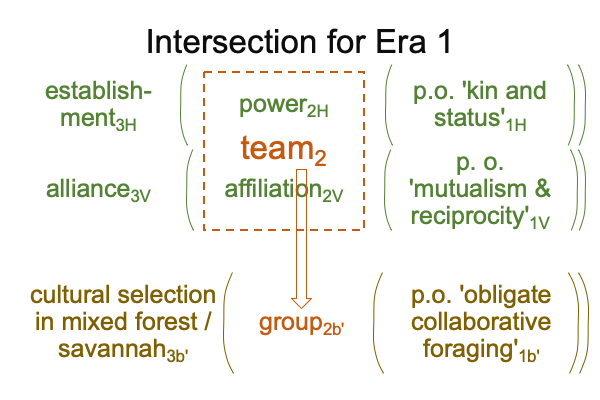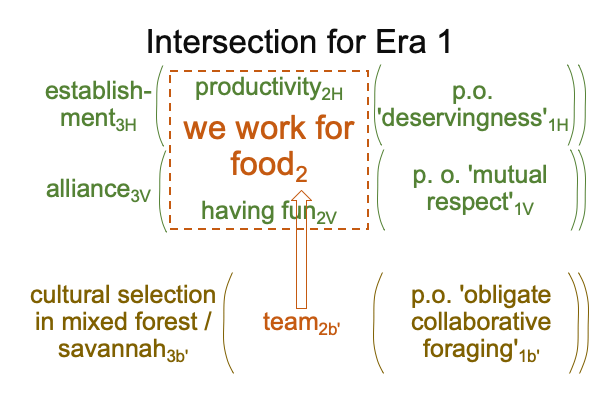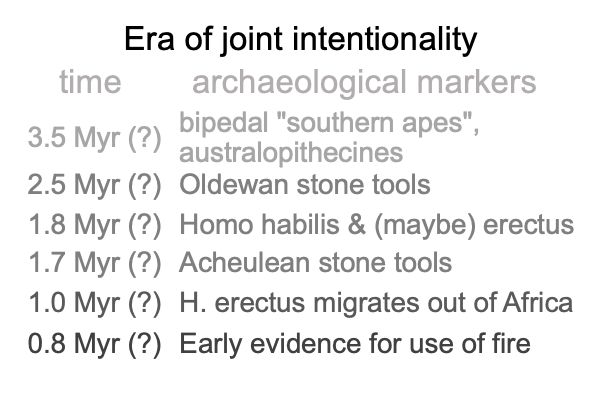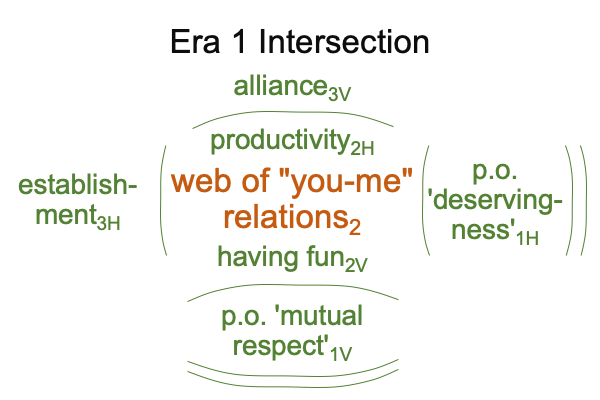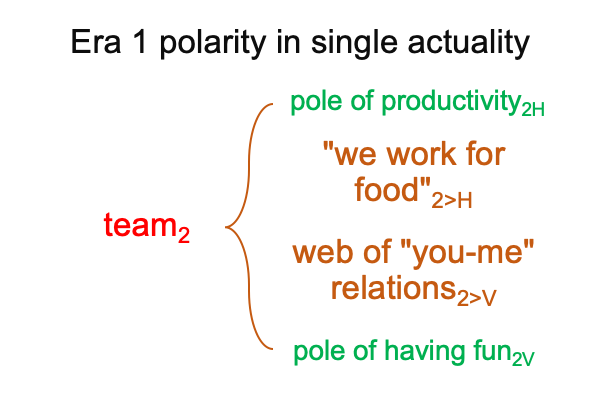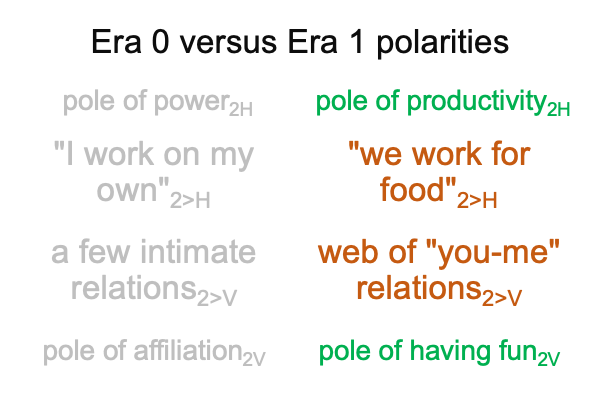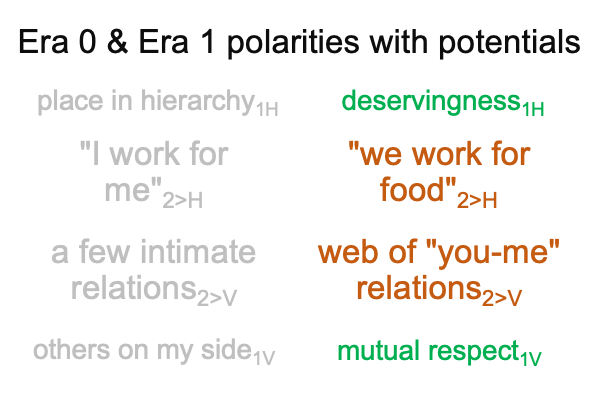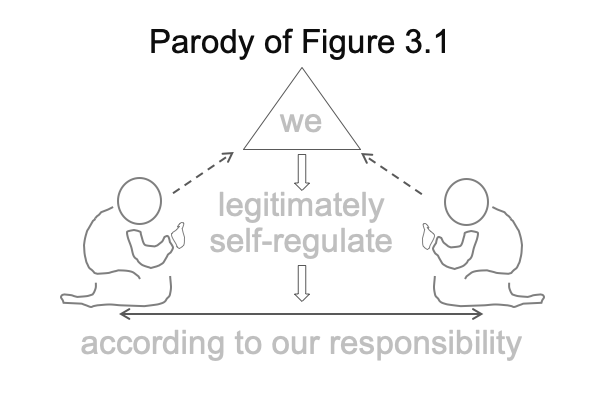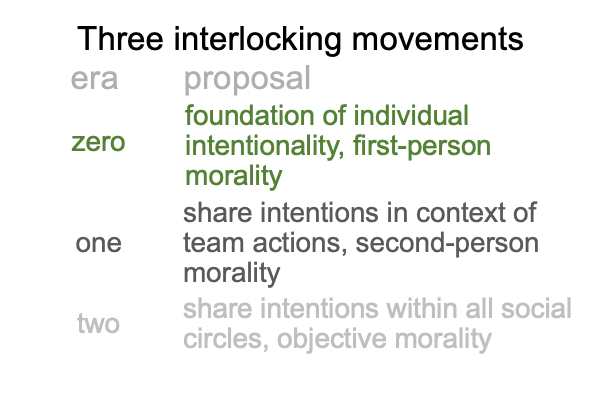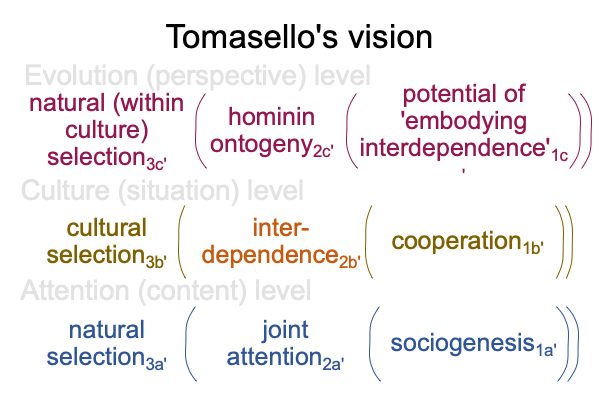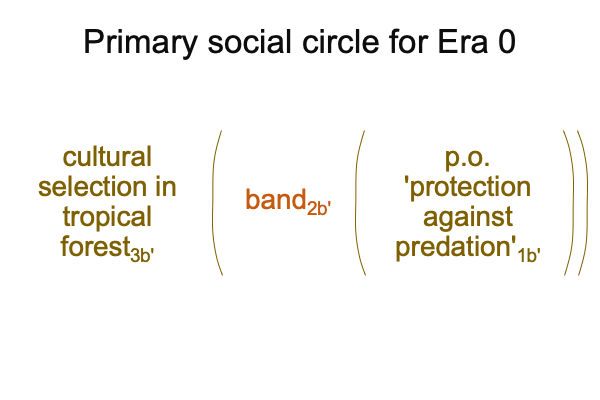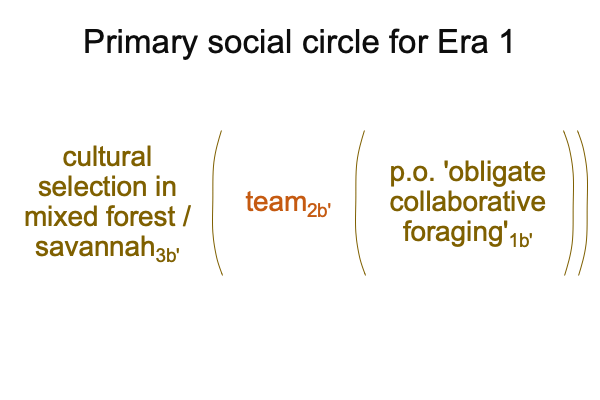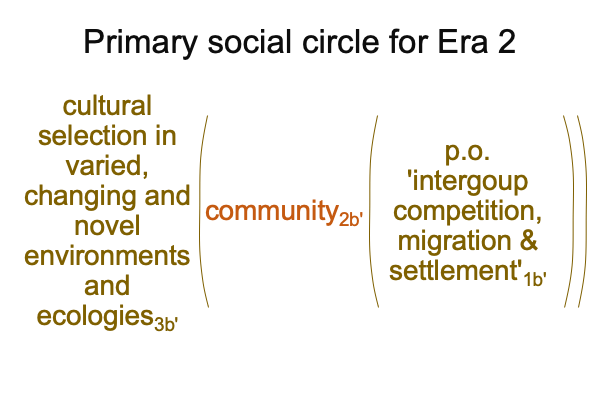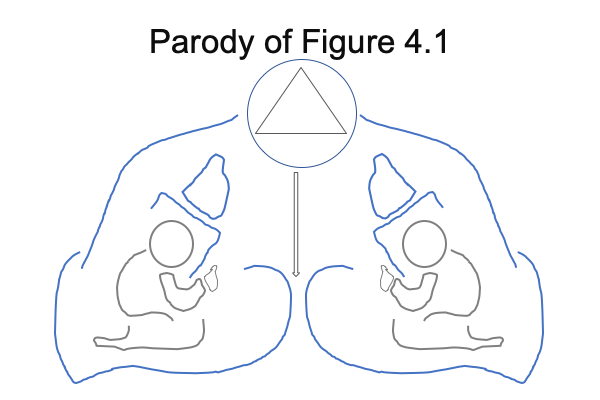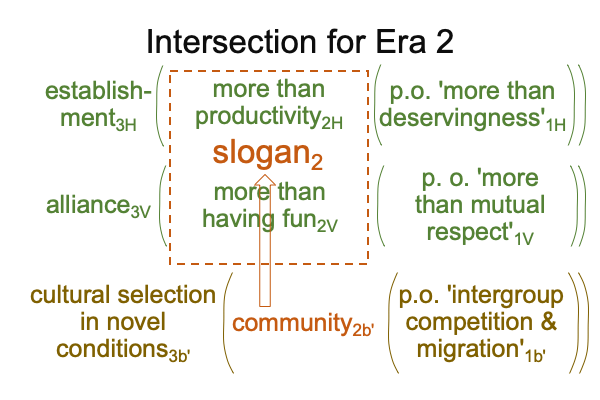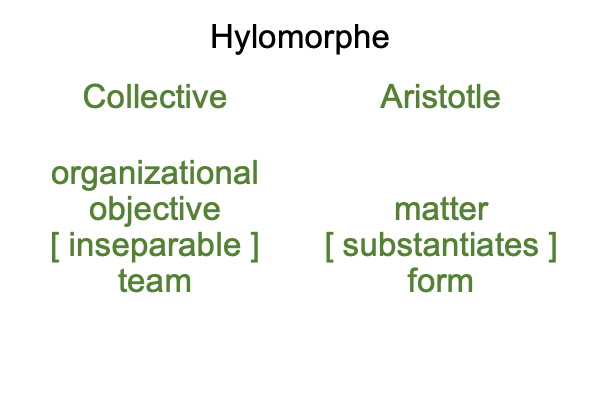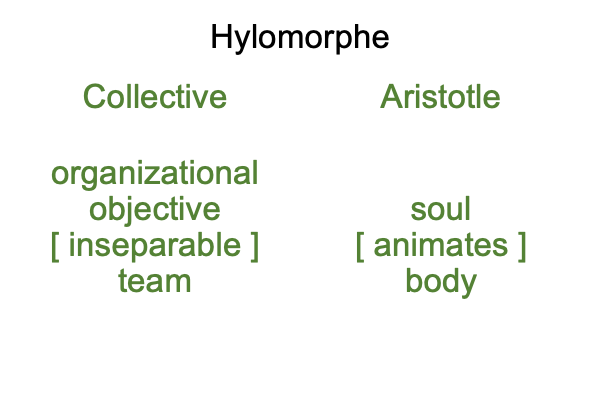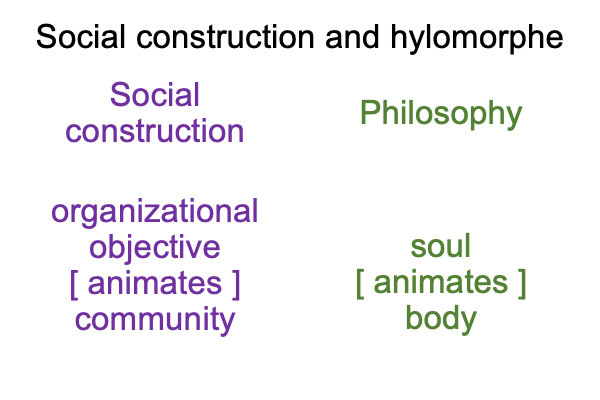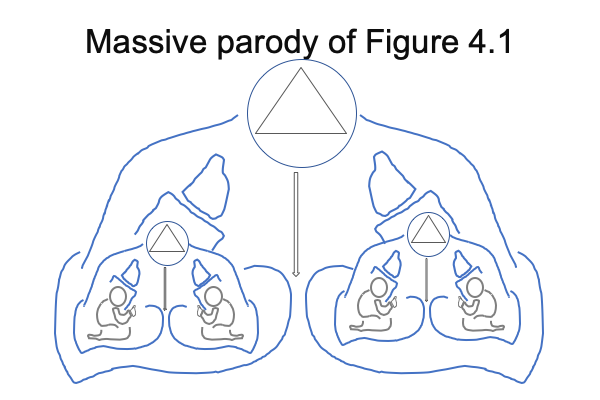Looking at Michael Tomasello’s Book (2016) “A Natural History of Human Morality” (Part 4 of 22)
0413 Tomasello proposes three interlocking movements to the natural history of human cognition.
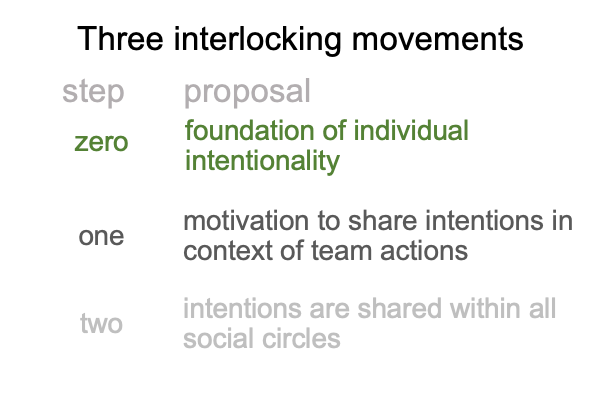
Then, he discusses two steps. First, there is the era of joint intentionality. Second, there is the era of collective intentionality.
So, there is terminological confusion, leading me to number the era of individual intentionality as “zero”.
0414 My explanation for this incoherent nomenclature calls to mind Tomasello’s vision, where the phenotype of human ontogeny2c occupies the perspective-level actuality and the adaptation of joint and collective attention2a occupies the content-level actuality. Research into early human cognitive development2c must somehow connect with research into the cognition of great apes2a. Tomasello projects the cognitive development of newborns and infants backwards, into evolutionary time, towards the last common ancestor (LCA), represented by cognitive research into the behaviors of great apes.
So, there are three eras and two steps, which does not sound bad, because not much happens in the first era.
But, there is another issue.
0415 On top of the incoherent nomenclature, Tomasello frames the era of joint intentionality as occurring after the appearance of the Homo genus, which occurs 1.8Myr (millions of years ago). He starts the era of collective intentionalitywith the appearance of new species, such as Homo heidelbergensis, around 0.5Myr. The first guess is not reasonable. The second is more plausible.
How so?
0416 Consider the archeological record for artifacts.
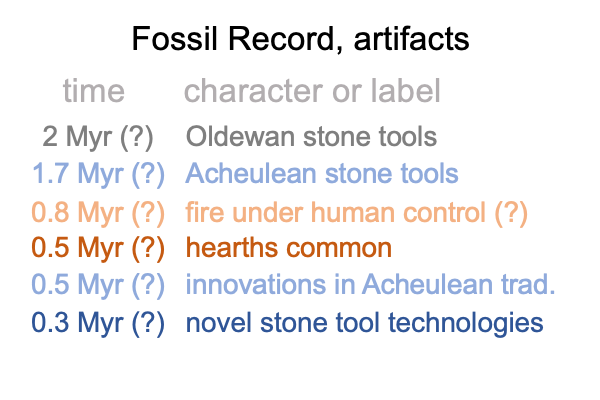
0417 Two pairs stand out.
The first is the pair of Oldowan, then Acheulean stone-tool technologies. These archaeological artifacts associate to one team among many. Consequently, they represent the era of joint intentionality.
The second pair is intimations of the use of fire, and then, the domestication of fire. These archaeological artifacts associate to the era of collective intentionality, for the obvious reason that cooking presents the opportunity for common meals that are not like the prior sharing of abundance from teams. Cooking produces qualitatively different food sharing opportunities. More teams means more food and a more varied menu. Then, the hearth itself provides a site for parties to linger and tell stories in hand talk. During this era, hand talk become fully linguistic. General grammar evolves.
0418 To me, these two pairs associate to the two steps in human evolution that Tomasello identifies.
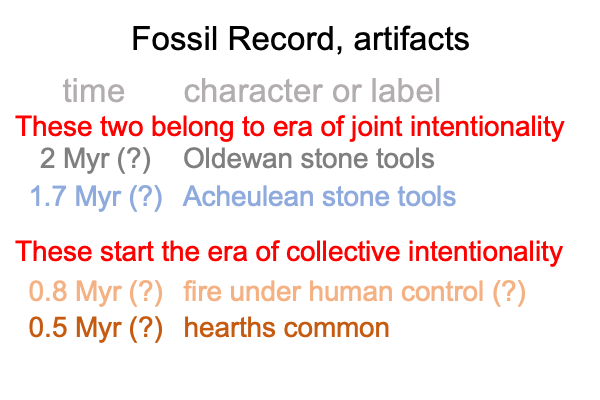
0419 Consequently, my associations to Tomasello’s eras does not coincide with his own.
0420 But, that is not all.
With this adjustment in mind, I would think that the natural history of morality would commence in step one. But, Tomasello does not start in step one. Chapter two, titled “Evolution of Cooperation”, points to step zero… er… the first era.
0421 Tomasello introduces the question, “Why sociality?”
The first and most primordial answer says, “Bands serve as protection against predators.”
But, safety in numbers comes at a cost. Each member of the band competes for access to resources. Hierarchies get established. Alliances form. Hierarchies and alliances are not the same. Each bears its own actuality.
0422 Here are two nested forms.

0423 Power2 does not situate affiliation2. Affiliation2 does not situate power2.
Both are in dynamic equilibrium.
0424 Such is life in the era of individual intentionality.
0425 Evolutionary anthropologists observe and measure the behaviors of great apes, who come as close to any creature to our ancestors living during the millions of years between the LCA and the bipedal “southern apes”. Evolutionary anthropologists model ape-behavior by asking the question, “How does each strategy of group living contribute to getting one’s genes into the next generation?”
Strategies for success include kin selection, group selection and selection for mutualism and reciprocity. I suppose the first item coheres to establishment3 and the latter items go with alliance formation3. Group selection is the odd inclusion, due to the fact that neither establishment3 nor alliances3 can exclude one another, try as they might. If establishment3dominates, then the group fails from passivity and free-riding. If alliance3 dominates, then the group fails from internal conflict.
0426 What does this imply?
Ah, power2 and affiliation2 must constitute a single actuality2.
That actuality2, in this case, is a social circle, or a group, called “band”.

The technical term for this relational structure is “intersection”. Two actualities intersect.
0427 Kin selection favors establishment3H.
Selection for mutualism and reciprocity favor alliances3V.
Group selection contains the contradictions between power2 and affiliation2.
So, the group must be the single actuality.
0428 I wonder, “Do evolutionary anthropologists, such as Tomasello, implicitly (not explicitly) realize this?”
In other words, if the single actuality2, the group2, associates to one of the actualities in Tomasello’s vision, then I would say that it2 is neither shared intentionality2a nor human ontology2c. Therefore, the group2 must associate to culture2b… I mean to say… interdependence2b.
Here is a picture.

0429 Why is the intersection so important?
Interdependence2b belongs to secondness, the realm of actuality, for both the nested form and the level.
On the content level, natural selection3a is the normal context where joint attention2a emerges from (and situates) sociogenesis1a (which turns out to be the potential of triadic relations).
On the situation level, cultural selection3b is the normal context where interdependence2b (starting with the either family, intimates or the band, in the era of individual intentionality) emerges from and situates cooperation1b (which is the potential1b of shared intentionality2a).
On the perspective level, natural selection (in milieu of culture)3c is the normal context where the hominin phenotype2cemerges from and situates the potential of ’embodying interdependence’1c.
0430 What factor is an evolutionary anthropologist to fixate on?
On top of that, interdependence2b exhibits the relational structure of an intersection.
An intersection is full of contradictions.
In the extreme, establishment3H without alliance3V produces the magnificent peacock and his fickle and easily seduced hens.
In the extreme, alliance3V without establishment3H produces the ant, where each worker shares the genes of every other worker and the queen holds authority because she is the one who gives life to the colony.
0431 Weirdly, both the peacock and the ant serve as metaphors for hominin society.
If the group2 embodies interdependence2b, then specialized academic inquiry into human evolutionary history tends to focus on the trees, without regard to the forest. Kin selection promotes establishment3H. Selection for mutualism and reciprocity promotes alliance3V. And group selection? How on earth can group selection contribute to reproductive success for an individual?
0432 Computer simulations abound.
But, the resolution stands beyond mere calculation.
Why?
Intersections are inherently mysterious.



